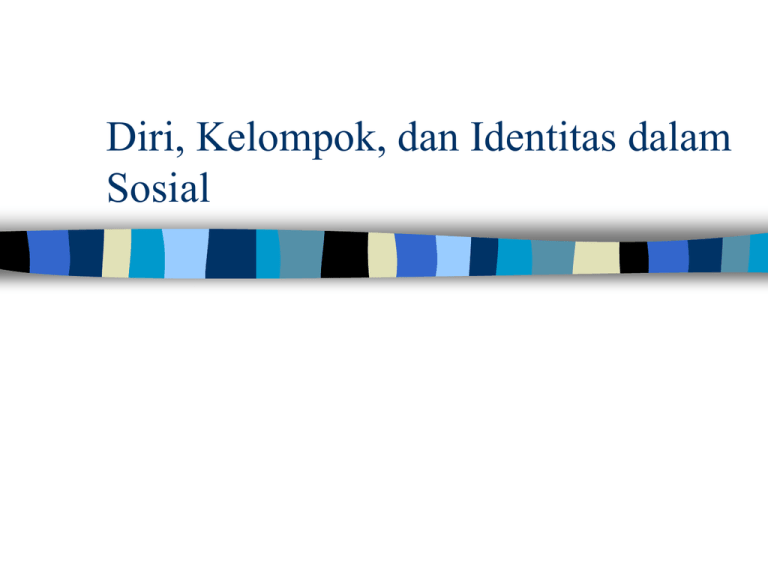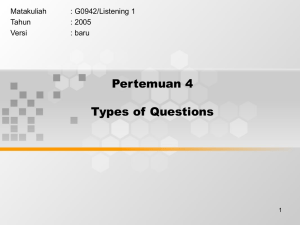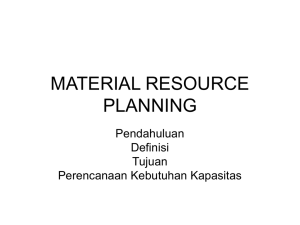Diri, Kelompok, dan Identitas dalam Sosial
advertisement

Diri, Kelompok, dan Identitas dalam Sosial Siapakah Saya? Konsep Diri……... Sebuah konsep yang sangat penting dalam psikologi sosial Mempengaruhi perilaku seseorang, dan…. Pembentukannya dipengaruhi oleh orang lain dalam proses interaksi sosial Konsep Diri: Identitas diri seseorang yang merupakan sebuah skema yang berisi kumpulan belief dan perasaan mengenai diri sendiri. Komponen Konsep Diri interpersonal attributes ascribed characteristics interest & activities existential aspects self determination internalized beliefs self-awareness social differentiation Identitas Sosial Definisi seseorang mengenai siapa ia; di dalamnya termasuk atribusi personal (self concept) yang sesuai dengan keanggotaannya dalam berbagai kelompok. Self Reference Effect Suatu proses kognisi dimana informasi yang berkaitan dengan diri diproses lebih cepat dibanding informasi jenis lainnya. Possible self Representasi mental yang berisi pemahaman mengenai gambaran diri yang diinginkan pada masa yang akan datang. Self Esteem Suatu evaluasi diri yang dibuat oleh setiap individu Suatu sikap mengenai diri sendiri dalam dimensi positif-negatif Self Focusing Tingkah laku untuk sejauh mana mengarahkan perhatian ke dalam diri atau ke lingkungan luar diri Self Monitoring Pengaturan tingkah laku individu berdasarkan pada situasi eksternal dan reaksi orang lain (high self monitoring) atau berdasar pada faktor internal seperti beliefs, sikap dan nilai (low self monitoring) Self Efficacy Evaluasi seseorang mengenai kemampuan atau kompetensinya dalam menyelesaikan tugas, mencapai tujuan, atau mengatasi masalah. Self Efficacy dan Prestasi Prestasi dalam bidang akademik maupun dalam bidang fisik meningkat seiring dengan tingginya self efficacy yang dimiliki individu. Self Efficacy dan Prestasi Gould & Weiss (1981): individu yang tinggi dalam self efficacy pada bidang atletik dapat melakukan latihan lebih lama daripada yang memiliki self efficacy rendah. Reasoning: tubuh menghasilkan endogenous opioids-natural painkiller. Courneya & McAuley, 1993: Self efficacy dalam bidang kemampuan fisik juga menyebabkan individu mampu mempersepsi kesuksesan dalam latihannya serta memiliki personal control terhadap tingkah lakunya. Sex versus Gender Sex vs Gender Sex: mengacu pada perbedaan anatomi dan fisiologi dari laki-laki dan perempuan yang berdasar pada masalah genetika. Gender: digunakan untuk menjelaskan tingkah laku yang berasosiasi dengan jenis kelamin yang diperoleh dari harapan budaya atau kombinasi dari faktor budaya & biologi Gender Identity Jenis kelamin (laki-laki atau perempuan) yang diidentifikasi seseorang sebagai identitas dirinya, biasanya, walau tidak selalu, berkaitan dengan jenis kelamin biologisnya. Bem Sex-Role Inventory Suatu pengukuran psikologis untuk melihat sejauh mana deskripsi diri seseorang dikarakteristikkan oleh maskulinitas tradisional, feminitas tradisional, gabungan keduanya (androgyny), atau tidak keduanya (undifferentiated). Androgyny Kecenderungan untuk memiliki karakteristik baik maskulin maupun feminin secara tradisional GROUP AND INDIVIDUAL : THE COSEQUENCES OF BELONGING GROUPS : A collection of persons who are perceived to be bonded together in a coherent unit to some degree. Perceived ENTATIVITY : The extent to which a group is being perceived as being coherent entity (Campbell, 1958). Is important because it determined What Makes a group is (really) a Group. Exp: People line at a bank (score entativity = 2.40) People who live in the same neighborhood (4.78) Sport Team (8,27) This rating is influenced by: to the degree to which group members interacted with one another Type groups usually identified by their members Intimacy group (family, relatives) Task oriented group (committee, work group) Weak social relationship or Associations (RT/RW, Kelompok mancing, dsb). How Groups Function: Roles, Status, Norms, Cohesiveness How precisely do groups affect their members ? through mechanism of : Group Roles, Status, Norms & Cohesiveness. ROLES: Sets of behaviors that individuals occupying specific positions within a group are expected to perform. STATUS : Position or rank within a group. NORMS : Rules within a group indicating how its members should or should not behaves. COHESIVENESS: All forces (factors) that cause groups members to remain in that groups. HOW GROUPS AFFECT INDIVIDUAL PERFORMANCE: From SOCIAL FACILITATION to SOCIAL LOAFING Social facilitation: Effects upon performance resulting from the presence of others. Drive theory of social facilitation: A Theory suggesting that the mere presence of others is arousing and increases the tendency to perform dominant responses. If dominant responses are correct in The present situation Presence of others (either as an audi ence or as co actors Heightened Arousal Performance is enhanced Enhanced tendency to perform dominant responses If dominant responses are incorrect in The present situation Performance is enhanced From Drive to Attentional focus: How does the presence of others influence task performance ? Evaluation Apprehension: Concern over being evaluated by others. Such concern can increase arousal and so contribute to social facilitation Distraction-conflict theory: A theory suggesting that social facilitation stems from the conflict produced when individuals attempt, simultaneously, to pay attention to other persons and to the task being performed. Social Loafing: Letting Others Do the Work When Part of a Group Additive Task: Task for which the group product is the sum or combination of the efforts of individual members. Social Loafing: Reduction in motivation and effort when individuals work collectively in a group compared to when the work individually or as independent coactors Collective effort Model: An explanation of social loafing suggesting that perceived links between individuals effort and their outcomes are weaker when they work together with others in a group. This, in turn, produces tendencies toward social loafing. Cooperation & Competition (Conflict) Cooperation: Behavior in which groups work together to attain shared goals Conflict : A process in which individuals or groups perceive that others have taken or will soon take actions incompatible with their own interest Social Dilemmas: Situation on which each person can increase his or her individuals gains by acting in one way, but if all (or most) persons do the same thing, the outcomes experienced by all are reduced Factors influencing cooperations; Reciprocity, Personal Orientations & Communication Reciprocity : A basic rule of social life suggesting that individuals tend to treat others as these persons have treated them. reciprocal altruism. Personal orientation : orientation of person toward situation: cooperative, individualistic or competitive orientation ? Communication; Individuals can use communication to discuss the situation, try to seek best alternative solution through communication. The Discontinuity Effect : Why Groups are more competitive than Individuals There is a tendecy that gorup are competitive than individuals, because: 1) People tend to distrust other groups more than other persons. 2) Easy to convince people that it is appropriate if a groups was selfish than individuals 3) in Individuals setting the are easily identifiable, than if they are in group (anonimity) Conflict: Its Nature, Causes and Effects Opposing interest Between the two sides Belief by each side that other will or has already taken Actions contrary to their interest Conflict Recogniton of these opposing interest Actions that interfere With others side’s interest Major Causes of Conflict: Faulty attribution : errors consering the causes behind other’s behavior Faulty communication with anger Bias of Ideology: our won gorup are right the other are wrong. Personality traits or characteristic: Type A : very competitive Bargaining (negotiation): A process in which opposing side exchange offers, counteroffers, and concession, either directly or through representative Superordinate Goals: Create common goals, Goals that are both sides to a conflict seek and that tie teir interset together rather than drive them apart. Culture & Conflict : Focus on relation or Outcomes ?: Research finding indicate that indivioduals tend to focus more on relational factors in conflicts within their own cultural or ethnic group, but more on outcomes in conflict that occurs accros cultural or ethnic boundaries. These finding have important implication for efforts to resolve social conflicts. Perceived Fairness in Groups Distributive justice (equity): refers to individuals judgement about wether they are receiving a fair share of available reawards– a share proportionate to their contributions to the groups ( or to any social relationship) Procedural Justice : The fairness of the procedures used to distribute available reawards among group members. Interactional (interpersonal) justice: The extent to which persons who distribute reawards explain or justify their decisions and show considerateness and courtesy to those who receive the rawards. Conflict is Low Conflict is High Couples focus little attention On perceived unfairness Couples focus more attention On perceived unfairness Conflict is Intensified Decission Making in Group Decission making: Processes involved in combing and integrating available information in order to choose one of several possible courses of action, Social Decision Schemes: Rules relating the initial distribution of member’s views to final group decisions. Group Polarization: The tendency of agroup members, as a results of group discussion, to shift toward more extreme positions than those they initially held Groupthink: The tendency of the members of highly cohesive groups to assume that their decisions can’t be wrong, that all members must support the group’s decision strongly, and that information contrary to it should be ignored. Devil’s advocate technique: A technique for improving the quality of group decision in which one group member is assigned the task of disagreeing with and criticizing whatever plan or decision is under consideration Authentic dissent: A technique for improving the quality of group decisions in which one or more group members actively disgree with the group’s initial preference without being assigned this role.

